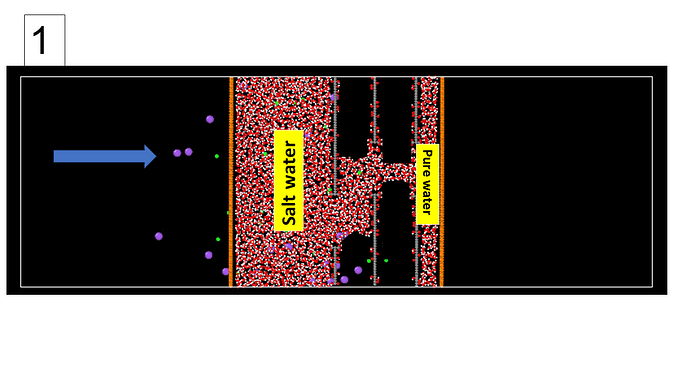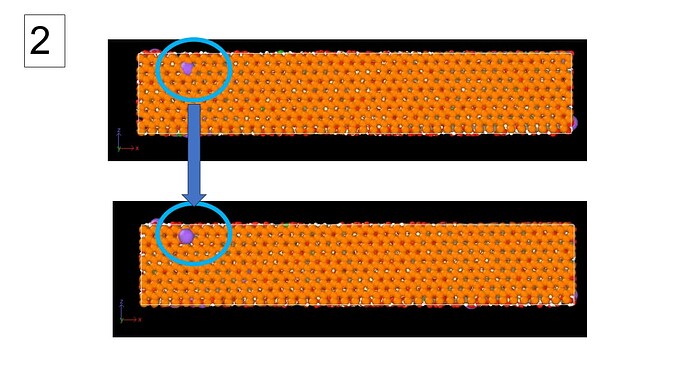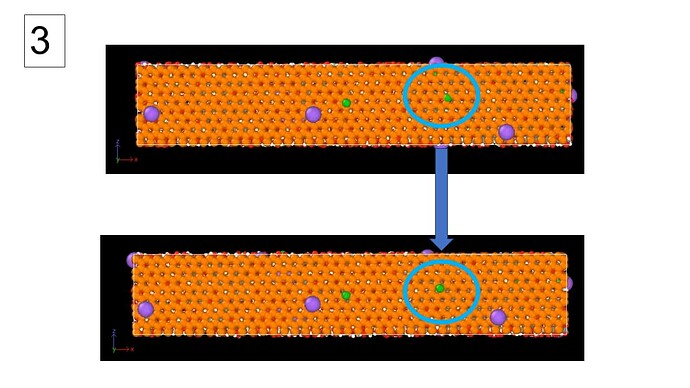Dear all,
I am studying the reverse osmosis desalination process using a graphene oxide membrane through molecular dynamics simulation with LAMMPS. My system consists of a double-layer graphene oxide membrane, a saltwater reservoir, a freshwater reservoir, and two pistons on the left and right sides (colored orange).
The issue I am encountering during the simulation is that shortly after the simulation starts, sodium and chloride ions leave the saltwater reservoir and, quite strangely, pass through the carbon atoms of the left piston, entering the left side of the saltwater chamber.
This problem occurs both when the left and right pistons are fixed and when they are under a pressure of one atmosphere.
In Figure 1, I have shown the complete schematic of the system. The blue arrow indicates the escape of sodium and chloride ions through the left piston.
Figure 2 illustrates the passage of a sodium ion through the carbon atoms, followed by its complete escape over time during the simulation.
Figure 3 shows a similar case for a chloride ion passing through the carbon atoms and exiting completely during the simulation.
I have also attached the input file below.
I kindly ask for your guidance in resolving this issue.
With best regards and many thanks
1.input (5.1 KB)
It’s generally a sign that your cross-coefficients are incorrect. Most likely, the sigma value of your carbon-ion potential is too small.
Please note that questions of this nature should be discussed with your advisor or someone directly involved in your research.
Simon
1 Like
Dear Simon,
Thank you for your response.
I have checked the cross-interactions and the potential several times,
but I didn’t find any problems.
It’s hard to believe, but if the parameters are indeed correct and you still see ions crossing the piston, then either:
- The force field is not suitable for what you’re trying to achieve, or
- Your system is experiencing extreme pressure values.
But again, its most likely your parameters.
First of all, this is a problem of the science you want to implement, and not a LAMMPS problem and thus your question is off-topic for the LAMMPS part of MatSci.org. I will thus recategorize this discussion to the “Science Talk” section.
When the system is not behaving the way you expect, that means that either your simulation conditions (force field, settings, etc.) are not what they should be, or your expectations are not correct. You need a domain expert to discuss this with, not a LAMMPS expert. We can only guess. So better talk to your adviser and colleagues or collaborators that are knowledgeable in your specific area of research.
As @simongravelle already stated, I would also suspect the choice of force field and force field parameters. It is very suspicious that you generate all mixed terms from a mixing rule. You probably need a custom parameterization exactly for your system.
Dear Simon,
Thank you for your reply.
Dear Dr. Axel Kohlmeyer
Yes, my apologies. You are right, and my question is not related to the LAMMPS part.
Thank you for your guidance.


